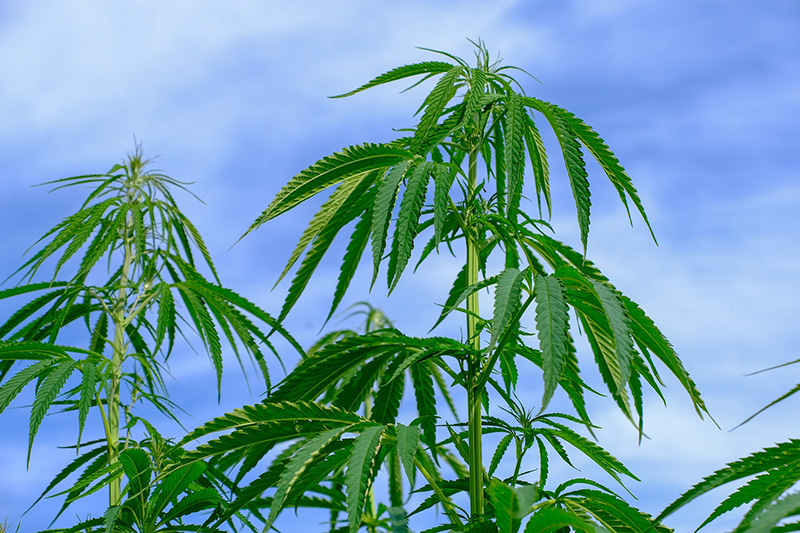Table of Contents [show]

The therapeutic use of Cannabis for various medical conditions is gaining widespread acceptance, given the growing body of research supporting its efficacy. Alleviating stress is the biggest concern these days. Prevalent conditions in contemporary society have been shown to respond positively to certain Cannabis strains, making treatments for alleviating stress and anxiety easier than ever.
This piece today will explore three strains that we believe best alleviate stress. – Cannatonic, Granddaddy Purple, and ACDC – for their efficacy in managing anxiety and stress. These strains were chosen due to their specific Cannabinoid profile, terpene content, and anecdotal evidence suggesting their beneficial effects in managing stress and anxiety.
-
Cannatonic and Alleviating Stress
Cannatonic is a hybrid strain cultivated by Resin Seeds with a balanced THC:CBD ratio, typically around 1:11. While THC is renowned for its psychoactive effects, CBD is a non-psychoactive compound known for its therapeutic properties, including potential anxiety relief2. The balance in Cannatonic is particularly suitable for people who are susceptible to THC-induced anxiety, allowing users to experience the benefits of THC without the associated adverse effects.
Myrcene, a terpene prominent in Cannatonic, is believed to have sedative properties and may synergistically work with Cannabinoids to alleviate stress and halt anxiety3. For optimal results, Cannatonic should be consumed using a dry herb vaporizer to prevent the destruction of terpenes and cannabinoids at high temperatures, thus ensuring maximum efficacy4.
-
Granddaddy Purple
Granddaddy Purple (GDP), developed by Ken Estes in 2003, is an Indica strain recognized for its calming effects5. Indica strains are traditionally believed to promote relaxation, which can be beneficial for individuals battling stress and anxiety. GDP is relatively high in THC, which might be beneficial for those not susceptible to THC-induced anxiety.
GDP is rich in the terpene Caryophyllene, known for its potential to interact with the endocannabinoid system and provide anxiety and stress relief6. Additionally, GDP’s robust aroma, characterized by its terpene profile, may offer aromatherapeutic benefits, enhancing its anxiety-relieving effects. As with Cannatonic, a dry herb vaporizer is recommended to maintain the strain’s complex terpene profile.
-
ACDC
ACDC, a phenotype of the Cannatonic strain, stands out for its remarkably high CBD to THC ratio, often as high as 20:17. Such a CBD-dominant strain could be particularly beneficial for those who are sensitive to THC’s psychoactive effects or those prone to THC-induced anxiety.
Furthermore, ACDC is rich in the terpene Myrcene, which, as discussed earlier, may augment CBD’s anxiety-relieving effects. To achieve the desired effects, ACDC can be consumed in various ways, including vaporization or as an edible. However, it’s essential to note that when consumed as an edible, the onset of effects may take longer, though they also tend to last longer8.
While the three strains – Cannatonic, Granddaddy Purple, and ACDC – are all potent options for alleviating stress and anxiety, their effectiveness is inextricably linked to the method of consumption.
-
Cannatonic
Cannatonic can be consumed in several ways, each of which affects the onset, intensity, and duration of effects. Vaporization is a commonly recommended method due to its rapid onset, typically within minutes1. Vaporizers allow for a lower temperature, which doesn’t degrade the cannabinoids and terpenes, thus ensuring maximum efficacy2.
Cannatonic can also be consumed as edibles or tinctures. Edibles are more discreet and provide a longer duration of effect, but the onset is delayed, typically 30-120 minutes after consumption3. On the other hand, tinctures, liquid cannabis extracts, allow for precise dosing and are an excellent choice for those who desire a quick onset without inhalation. An excellent strain for alleviating stress in the modern world.
-
Granddaddy Purple
Given its high THC content, Granddaddy Purple may be best suited to inhalation methods such as smoking or vaporization. Smoking offers quick relief, but the combustion can cause the degradation of cannabinoids and terpenes and may have potential health risks associated with inhaling smoke4.
Alternatively, vaporizing GDP at a lower temperature can preserve the terpenes and cannabinoids while minimizing potential respiratory risks associated with smoking5.
Edibles infused with GDP can offer a longer duration of relief, usually several hours, but they also have a slower onset of effects. Therefore, edibles may be more suitable for individuals who can anticipate their anxiety or stress episodes.
In my day, smoking marijuana was the only way for Alleviating Stress and Anxiety. It is nice to have options, and I have vaped cannabis before, and even used it in a several recipes, but smoking a joint always brings back better, more stress free living.
-
ACDC
Due to its high CBD and low THC content, ACDC can be consumed in a variety of ways, including inhalation (smoking or vaporizing), as edibles, or as tinctures.
Alleviating Stress and Anxiety Quickly
For immediate relief, smoking or vaporizing ACDC is an option. The onset is rapid, usually within minutes6. Vaporization is particularly recommended due to its efficiency in preserving CBD content and its lower respiratory risk compared to smoking7.
Edibles and tinctures containing ACDC provide longer-lasting relief but have a slower onset. However, these methods allow for more discreet use and precise dosing, making them excellent alternatives for those who don’t wish to inhale or need sustained relief over a more extended period.
Ultimately, the choice of consumption method should be based on individual needs, lifestyle, and comfort. It is crucial to remember to start with a low dose, especially with edibles, and gradually increase until the desired effect is achieved. A medical professional knowledgeable about cannabis should always be consulted when using these strains for therapeutic purposes.
How Certain Cannabis Strains Work to Alleviate Stress and Anxiety?
Cannabis is a very complex plant with over 120 identified chemical compounds known as cannabinoids. The two most well-studied are tetrahydrocannabinol (THC) and cannabidiol (CBD), but other cannabinoids and terpenes also play a role in the plant’s effects.
Here is a brief overview of how they may help with PTSD:
- CBD: CBD is non-psychoactive, meaning it doesn’t cause the “high” associated with cannabis. It is known to have a wide range of therapeutic applications. For PTSD, CBD can potentially reduce anxiety and improve sleep, two of the most significant issues for people with this condition.
- THC: This is the psychoactive component that makes people feel “high.” For PTSD, it can help reduce anxiety in some people and induce sleep, but it can also worsen anxiety and other symptoms in others, depending on the dose and the individual’s response. Therefore, it’s crucial to use THC under guidance.
- The Entourage Effect: This is a term used to describe the synergistic effects of different cannabinoids and terpenes when they’re used together, as they naturally occur in the cannabis plant. Some research suggests that the entourage effect may be beneficial for conditions like PTSD.
Best news yet, people using Cannabis for PTSD or anxiety do not have to stay high constantly to benefit from medicinal cannabis. Here’s why:
- Strains with a higher proportion of CBD and a lower proportion of THC can provide therapeutic effects without the high. These strains can help manage symptoms during the day when the psychoactive effects of THC would be undesirable.
- The use of products that are consumed orally or topically can have more prolonged effects and don’t necessarily cause a high, especially if they’re rich in CBD.
- People can develop a tolerance to the psychoactive effects of THC, which means they might not feel “high” even though they’re still getting the medicinal benefits.
However, it’s important to note that while cannabis can help manage symptoms, it doesn’t cure PTSD. Additionally, the effects of cannabis can vary greatly depending on the strain, the dosage, the method of consumption, and individual factors like genetics and tolerance.
Furthermore, there are potential risks and side effects associated with cannabis use, such as dependency and worsening of psychiatric symptoms, so it’s essential to discuss these factors and any potential interactions with other medications with a healthcare provider.
More About The Entourage Effect
The term “entourage effect” refers to the idea that the various compounds in cannabis can work together, or synergistically, to enhance or modify the potential health benefits of the plant. It’s the combined effect of different cannabinoids, terpenes, and other phytochemicals interacting together within the body to produce a broad range of potential outcomes.
The main idea behind the ‘entourage effect’ is that the whole cannabis plant, with all of its various compounds, is greater than the sum of its parts. For instance, some evidence suggests that CBD might help to moderate the psychoactive effects of THC, reducing potential side effects like anxiety and paranoia while still providing pain relief and alleviating stress and anxiety.
The two primary groups of compounds involved in the entourage effect are cannabinoids and terpenes:
- Cannabinoids: These are the most well-known and well-studied compounds in cannabis. THC and CBD are the most well-known, but there are over 120 others, including cannabinol (CBN), cannabigerol (CBG), and tetrahydrocannabivarin (THCV), each with its own set of potential therapeutic benefits.
- Terpenes: These are aromatic compounds found in many plants, including cannabis. They give cannabis strains their distinctive smells and flavors, from the citrusy scent of limonene to the piney aroma of pinene. But terpenes may also have their own therapeutic benefits, from potential anti-inflammatory effects to possible anxiety relief. There are over 200 terpenes in the cannabis plant.
In the context of PTSD treatment, alleviating stress or tackling anxiety, the entourage effect can be particularly significant. For instance, a strain of cannabis that contains a balance of THC, CBD, and specific terpenes like linalool (which has calming effects) and pinene (which has potential memory-enhancing effects) might be more effective at reducing anxiety, promoting sleep, and supporting overall emotional health than a strain that contains THC alone.
However, much of the evidence for the entourage effect is anecdotal or based on preclinical studies. More research is needed to understand exactly how these compounds interact and how these interactions can be leveraged to optimize cannabis-based treatments, but that work will get done.
It’s also important to note that the cannabis plant’s complexity makes it challenging to study and means that its effects can be unpredictable, varying from person to person and even from one use to the next. The elaborate footnotes at the end of this certainly demonstrates how much research is going on.
The research into cannabis and its effects on PTSD and other mental health conditions is constantly ongoing. I do recommend that you stay updated on the most recent scientific findings, as our understanding of this plant and its applications in medicine continue to evolve.
Alleviating Stress With Cannabis – A Conclusion
Cannatonic, Granddaddy Purple, and ACDC all provide unique cannabinoid profiles and terpene combinations, making them ideal for alleviating stress and anxiety . However, everyone reacts to Cannabis differently, and what works best for one individual may not work the same for another.
Therefore, when using Cannabis for therapeutic purposes, it’s always advised to start with a low dose and gradually increase until the desired effect is achieved. Consultation with healthcare professionals knowledgeable about Cannabis is also recommended for best outcomes. Don’t worry, the majority of people find their best strain, and consumption preference in a short time.
For more in-depth knowledge, feel free to dive into my Footnotes below.
- John Manzione
Footnotes For Alleviating Stress and Anxiety
- Resin Seeds. “Cannatonic”. https://www.resinseeds.net/cannatonic ↩
- Blessing, E. M., Steenkamp, M. M., Manzanares, J., & Marmar, C. R. (2015). “Cannabidiol as a Potential Treatment for Anxiety Disorders”. Neurotherapeutics, 12(4), 825–836. https://doi.org/10.1007/s13311-015-0387-1 ↩
- Russo, E. B. (2011). “Taming THC: potential cannabis synergy and phytocannabinoid-terpenoid entourage effects”. British Journal of Pharmacology, 163(7), 1344–1364. ↩
- Pomahacova, B., Van der Kooy, F., & Verpoorte, R. (2009). “Cannabis smoke condensate III: The cannabinoid content of vaporised Cannabis sativa”. Inhalation Toxicology, 21(13), 1108–1112. https://doi.org/10.3109/08958370902748559 ↩
- Estes, K. (2021). “Granddaddy Purple”. ↩
- Gertsch, J., Leonti, M., Raduner, S., Racz, I., Chen, J. Z., Xie, X. Q., Altmann, K. H., Karsak, M., & Zimmer, A. (2008). “Beta-caryophyllene is a dietary cannabinoid”. Proceedings of the National Academy of Sciences, 105(26), 9099–9104. https://doi.org/10.1073/pnas.0803601105 ↩
- Project CBD. “ACDC”. ↩
- Barrus, D. G., Capogrossi, K. L., Cates, S. C., Gourdet, C. K., Peiper, N. C., Novak, S. P., Lefever, T. W., & Wiley, J. L. (2016). “Tasty THC: Promises and Challenges of Cannabis Edibles”. Methods Report (RTI Press). ↩
- Huestis, M. A. (2007). “Human Cannabinoid Pharmacokinetics”. Chemistry & Biodiversity, 4(8), 1770–1804. https://doi.org/10.1002/cbdv.200790152 ↩
- Pomahacova, B., Van der Kooy, F., & Verpoorte, R. (2009). “Cannabis smoke condensate III: The cannabinoid content of vaporised Cannabis sativa”. Inhalation Toxicology, 21(13), 1108–1112. https://doi.org/10.3109/08958370902748559 ↩
- Barrus, D. G., Capogrossi, K. L., Cates, S. C., Gourdet, C. K., Peiper, N. C., Novak, S. P., Lefever, T. W., & Wiley, J. L. (2016). “Tasty THC: Promises and Challenges of Cannabis Edibles”. Methods Report (RTI Press). ↩
- Tashkin, D. P. (2013). “Effects of marijuana smoking on the lung”. Annals of the American Thoracic Society, 10(3), 239–247. https://doi.org/10.1513/AnnalsATS.201212-127FR ↩
- Gieringer, D., St. Laurent, J., & Goodrich, S. (2004). “Cannabis Vaporizer Combines Efficient Delivery of THC with Effective Suppression of Pyrolytic Compounds”. Journal of Cannabis Therapeutics, 4(1), 7-27. https://doi.org/10.1300/J175v04n01_02 ↩
- Huestis, M. A. (2007). “Human Cannabinoid Pharmacokinetics”. Chemistry & Biodiversity, 4(8), 1770–1804. https://doi.org/10.1002/cbdv.200790152 ↩
- Gieringer, D., St. Laurent, J., & Goodrich, S. (2004). “Cannabis Vaporizer Combines Efficient Delivery of THC with Effective Suppression of Pyrolytic Compounds”. Journal of Cannabis Therapeutics, 4(1), 7-27. https://doi.org/10.1300/J175v04n01_02 ↩




